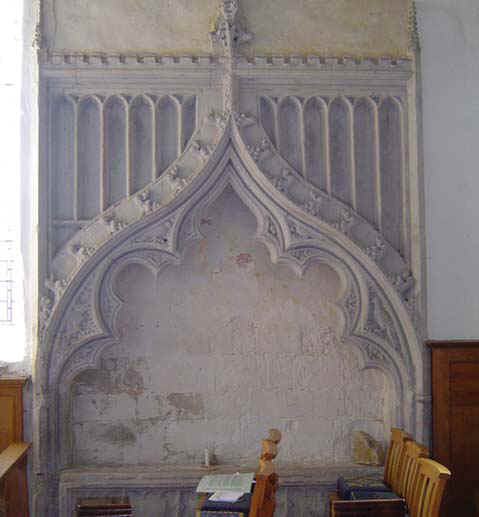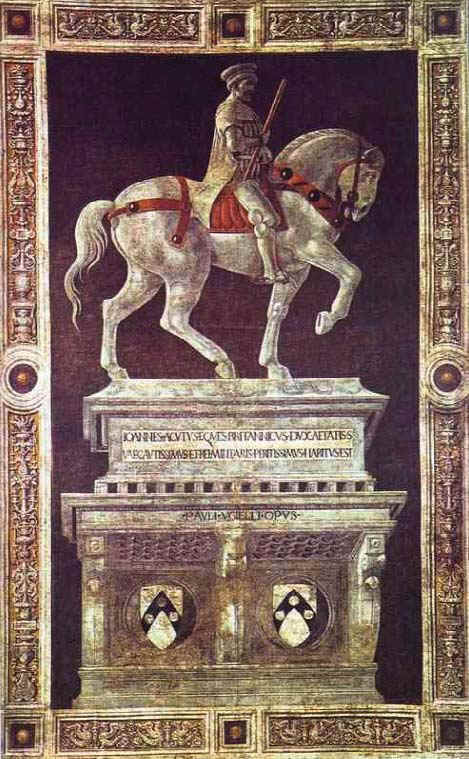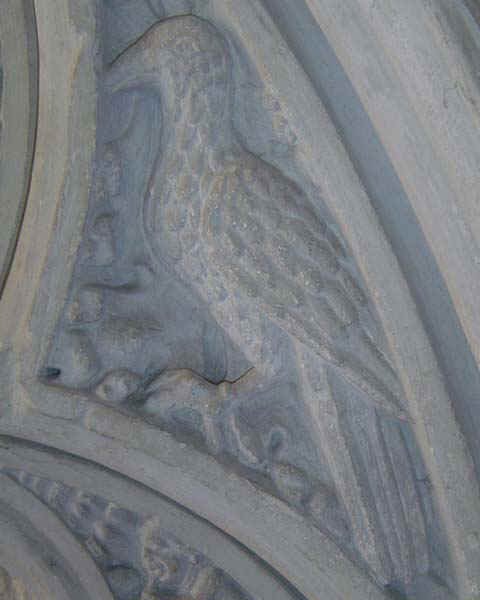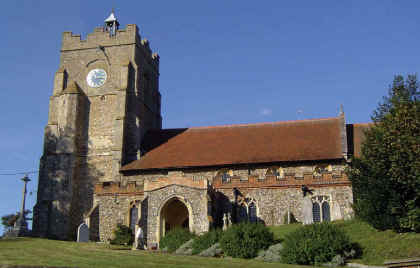From Sible Hedingham to Florence. The Remarkable Life of Sir John Hawkwood
A hefty padlock bars entry to the fourteenth century church of St Peter in Sible Hedingham. The village has in recent times become the focus of a particularly destructive breed of young vandal and the church is in a
permanent state of siege. As a result the casual visitor is denied access to the memorial which is to be found inside and which celebrates Sible Hedingham’s most famous son, Sir John Hawkwood. There is a certain irony in this, as Hawkwood’s fame was based on a career as one of the most notorious, destructive and successful bandits of medieval times. A contemporary, Sir Thomas Gray, (with remarkable prescience of the twentieth century vernacular), called the mercenaries which Hawkwood came to command “a horde of yobs.”
The memorial itself is remarkably modest for a man who became, amongst other things, captain-general of Florence, Duke of the Duchy of Spoleto and ambassador to the court of Richard II. All that remains of the memorial is a tomb recess in the south wall fronted by an elegant sculpted ogee arch. A number of carved stone hawks provide a clue to the subject of the memorial, although it is by no means certain that Hawkwood, who died in Florence in 1394, was ever buried here.
Enter the west door of the Duomo in Florence, accustom your eyes to the gloom, advance along the north aisle and in the third bay look up to your left. There you will see an enormous and magnificent (27 ft x 17 ft) fresco by Paolo Uccello of a military figure on horseback. Depicted as a statue standing on a plinth, there is nothing modest about this regal, triumphal figure. The Latin inscription identifies him as Ioannes Acutus and he is none other than Sir John Hawkwood, late of Sible Hedingham.

The Hawkwood Memorial. |
 |
|
The Fresco of Hawkwood |
Hawkwood was born in Sible Hedingham about 1320, his father being a free tenant of the de Veres of Hedingham Castle. In 1338 when Hawkwood was aged 18, Edward III took up arms to enforce his claim to the French throne,
thus starting the 100 years war. John de Vere, Seventh Earl of Oxford raised troops to support the king and Hawkwood, whose family knew the de Veres well, (his elder brother was a steward of the de Vere household), joined his feudal lord as an archer. At Crecy in 1346 Hawkwood commanded, with some distinction, a troop of 250 archers and at the battle of Poitiers ten years later he was knighted for his part in the victory. Morant the Essex historian, says of him that he was “accounted the poorest knight in the army.”
By early 1360 Edward was besieging Paris, but then things started to go wrong. The weather forced a retreat and later that year a treaty was signed at Bretigny under which Edward renounced his claim to the French throne; the French king, who was a prisoner in London, was to be ransomed for 3 million gold crowns, the cession of Guienne and Calais to the King of England was
confirmed and huge transfers, representing about a quarter of France were made to the English.
Edward and the Black Prince sailed back to England and so did many of the English troops (including Geoffrey Chaucer who had been captured by the French and ransomed for £16). But many of the soldiers who found themselves so suddenly unemployed stayed in France, and John Hawkwood (“finding his estate too small to support his title and dignity”) was one of them.
Readers of The White Company by Arthur Conan Doyle will know the 14th century as the age of chivalry, when gallant knights sought out heroic deeds that would bring them honour for the sake of their fair ladies. In spite of
this, the most barbarous acts of cruelty were committed without a second thought in the pursuit of what often, seem to us now, quite comical heroic ideals and the jousting which still takes place at Hedingham Castle is very much the sanitised side of the picture.
Beneath the heroic veneer, soldiers in the English army were recruited to the flag very largely by the prospect of plunder. Armies were made up of small groups of soldiers who owed allegiance to their feudal chief but were in fact
mercenaries whose main motivation was to grow rich on loot and ransom. As a result of the plague which rampaged throughout the 14th century and killed almost half of the population in Europe, there was everywhere a shortage of manpower, the social order had been greatly disrupted and it was possible to make the transition from servant to knight at break-neck speed. In the course of the war, vast areas of France had been pillaged and following the peace, the campaign of terror continued in total disregard of the order that all men-of-war should leave France. Of the leaders of the mercenary bands that were left in France after the treaty of Bretigny, John Hawkwood stood out as by far the most able, and by the end of the year his mercenaries were threatening the Pope who at that time had withdrawn his court to Avignon. The Pope eventually bought them off, and Hawkwood, at the Pope’s instigation, left France to do battle with the Visconti, the rulers of Milan.
Italy in the 14th century was the most successful country in Europe, but divided into competing city states which were almost permanently at war with each other. From his base in Avignon the Pope attempted to control his possessions in Italy while trying to prevent any single city state becoming too dominant. The country was ripe for exploitation by the mercenary armies who were hired by all parties, changed sides at the drop of a hat, extorted huge ransoms from clients and enemies alike, and behaved with the utmost barbarity.

Detail on Hawkwood tomb.
Hawkwood became leader of the White Company in 1363 and very soon proved a master in the business of pillage, blackmail and duplicity. Over the next 30 years he fought both for and against the Pope, Florence, Milan, Pisa, Siena and Perugia. Vast bribes were extracted from all of them and such was Hawkwood’s military reputation that he never lacked for clients prepared to employ him, despite the fact that over the years he betrayed them all. Unfortunately, they had no alternative as the city states mostly did not have their own standing armies and were therefore forced to employ mercenaries to do their fighting for them.
The White Company was very highly organized – its modern equivalent, though on a much smaller scale, might be the yakuza (gangster) gangs in Japan. Apart
from the soldiery the company employed lawyers and notaries to keep track of bribes and ransoms, sort out contracts and provide safe passes. Accountants and secretaries were a further necessary part of the organization as plunder had to be divided up among the troops who then sold their share through outside brokers. Also attached to the company were a huge retinue of priests, prostitutes, cooks, barbers, jesters and doctors.
The basic fighting unit was called a lance and consisted of a mounted soldier, an archer and a page. When ready to engage , they all dismounted and while the archer and the soldier wielded the lance, the page held back the horses. In the 14th century, the English longbow was the state of the art weapon. Archers could loose off 20 arrows in the minute that it took for a crossbowman to reload and they could do so with incredible accuracy – it was verging on the suicidal to put ones head above the parapet.
The mercenary companies’ method of operating was usually to set up camp under the city walls of their intended victim and then see if they could extract a bribe for not attacking. If that failed or if the bribe was insufficient, they would use scaling ladders to get into the town, torch the greater part of it, ransom anyone of consequence and carry off or rape the women.
The campaign against the Visconti having reached stalemate, a truce was called and this gave Hawkwood the opportunity to transfer his services to Pisa. Over the next thirty years, his allegiance changed with bewildering
frequency as he fought for and against Milan, Pisa, Florence, Perugia, Siena and the Papacy. So great was his influence that he was involved in arranging the marriage of Edward III’s third son , the Duke of Clarence, to the daughter of the Duke of Milan. (Clarence died some four months after the wedding – possibly poisoned). Hawkwood’s position received further recognition when he married the (admittedly illegitimate) daughter of the duke of Milan’s brother. Hawkwood was 57 and she was 17.
Florence offered perhaps the most consistent rewards, and Hawkwood, to quote Morant, the Essex historian, “continued to the last, General of the Florentines, whom he served with such happy success, that he may well be
stiled (sic) the founder or establisher of their Republic. At length, this valiant knight, loaden with honor and riches, died, in a very advanced age, at Florence, in 1394.”
So died “the ablest military commander of the Middle Ages.” He had, so to speak, spent the whole of his long life in the saddle. At the very end of his life, in true mercenary fashion he appears to have run out of money, in contrast to Morant’s description of him being “loaden with riches”. Two letters survive, the oldest extant letters in the English language, giving instructions for the
disposal of his (modest) estates in England. The letters make clear his intention to come back to England, but he died first, thus triggering the instruction to establish a chantry to say prayers for him and his military comrades in the church at Sible Hedingham and the nunnery at Castle Hedingham.
His widow, on the other hand, does appear to have visited England to inspect the surviving Essex estates. The authorities in Florence wrote a letter of introduction to Richard II on her behalf and he replied by asking that Hawkwood’s remains be returned to England. The Florentines reluctantly agreed, though it transpired that he had been cremated and that what had been interred in the Duomo were “ashes and bones”. It is unknown whether the ashes were in fact returned, in which case they would presumably have been reburied in Sible Hedingham. There is a strange parallel here (c.f. Colne- Stour newsletter April 2004) with the reburial in 1395 at Earls Colne of Robert de Vere, Richard II’s favourite. Robert’s body had been brought back from France where he had been killed by a wild boar, and the King at the funeral had the coffin opened so that he could “look once more on the face of the man he loved.”
In 1395 as a memorial to Hawkwood, a fresco was commissioned for the cathedral in Florence. Forty years later, the original having faded or been damaged in some way, a replacement was painted by Paulo Uccello. The magnificent fresco of Hawkwood, holding aloft his baton of command, harks back to Roman antecedents and for obvious political reasons is designed to give him an aura of chivalry , rectitude and nobility – virtues that he never had in real life.
JEREMY HILL

